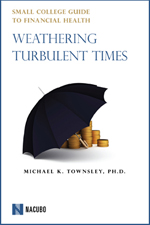A Financial Management Guide for Colleges, Universities & Schools
In this timely book, Michael Townsley examines the financial and strategic resources that private colleges and universities must have in place to withstand the storm. Small college presidents, CFOs, planners, chief academic officers, and board members all have a hand on the tiller and will find substantive guidance here on analyzing financial condition, reshaping strategy, implementing best practices, weathering rocky periods, and designing turnarounds.
Readers will learn:
- Current financial conditions and statistics for private colleges and universities
- Economics of markets, prices, and constraints that drive private institutions
- Common financial structures Model practices employed in a well-run business office
- Typical business models that are the framework for strategy, operations, and finance
- Recommended policies and procedures to safeguard against disaster
- Strategic planning for optimum performance
- Leadership qualities and characteristics
- Warning signs of financial distress
- Comparative case histories of private colleges that have succeeded and failed
- Lessons learned from college closures and steps for dramatic turnarounds
- A set of principles for building and sustaining strategic momentum.
Looking ahead to looming financial pressures, Townsley offers advice on maintaining a forward momentum detailing specific measures for monitoring performance and posing top-of-mind questions that will help financial officers maintain the vigilance required to turn a problem into an opportunity.
Well illustrated and documented with the latest statistics, Small College Guide to Financial Health: Weathering Turbulent Times includes a CD with basic templates for financial management.
We are proud of Dr. Townsley’s work and would like to share the insights of his book and accumulated higher education knowledge with you. We are offering a copy of Weathering Turbulent Times, along with a complimentary conference call with Dr. Townsley and other Stevens Strategy consultants to discuss your most challenging financial issue, to the first 20 inquirers. If you are interested in this opportunity, please contact us via our Contact Us page. For a sneak peak of the book, check out our most recent blog posting, Weathering Turbulent Times, Chapter 1, which is an excerpt from the first chapter of the book.
Chapter Titles and Key Bullet Points
Chapter 1: Introduction
Chapter 2: Private Colleges and Universities: In Danger or Not?
- Student Markets
- Academic Skills
- Operational Costs
- Financial Condition of Independent Colleges and Universities
- Summary
Chapter 3: The Economics of Higher Education: A Brief Lesson
- Quirky Aspects of the Marketplace
- Economic Models of Private Colleges and Universities
- How Does Economics Answer These Typical Questions?
- Summary
Chapter 4: Financial Structure
- How the Financial Structure Works
- Pricing Strategies
- Endowment Investments
- Capital Investments
- Financial Equilibrium
- Testing Changes in the Financial Structure
- Summary
Chapter 5: Financial Practices
- Budgets
- Business Standards: Generally Accepted Accounting Standards
- iv Small College guide: Weathering turbulent times
- Business Practices
- Financial Office Personnel Qualifications
- Business Office Reports
- Board Financial Oversight
- Debt Management
- Eight Principles of Financial Management
- Summary
Chapter 6: Business Models
- Tuition-Driven Models
- Price—Quality Model
- Residence Hall Model
- Athletics Revenue Model
- Endowment- and Gift-Driven Model
- Partnership Model
- Online Model
- Multinational Model
- Market Niches
- New Models
- Summary
Chapter 7: Operations: Management for Success
- Operational Statements
- Designing Operational Statements
- Operational Management: Achieving Financial Strength
- Operations: Capital Project Management
- Operational Controls
- Good People Equal Good Operations Management
- Summary
Chapter 8: Strategic Planning
- Market-Driven Strategic Planning
- Strategy Versus Incrementalism
- Strategic Planning 101
- Planning Under Financial Duress
- Planning Under Conditions of Financial Strength
- Basic Business Practices
- Keys to Financial Strategy
- Summary
- Contents v
Chapter 9: Leadership, Power, and Authority
- When Leadership Goes Missing
- What Makes a Leader?
- Shared Governance: A Common Theme in Higher Education
- Management-Style Governance
- Management Practices
- The Conundrum of Shared Governance
- Summary
Chapter 10: Financial Distress
- Warning Signs of Financial Distress
- The Bottom Line of Financial Distress
- How to Avoid Chronic Financial Distress
- Summary
Chapter 11: When Private Colleges Fail
- Antioch College
- Upsala College
- Bradford College
- Spring Garden College
- Maycrest International University
- Mount Senario College
- Other Sad Stories
- What Are the Lessons From These Failures?
- Summary
Chapter 12: How Private Colleges Turn Around and Flourish
- Wesley College
- Georgetown College
- Marylhurst College
- Nichols College
- Wilmington College (University)
- Gwynedd-Mercy College
- Flourishing Turnarounds: Basic Principles
- A Turnaround Strategy
Chapter 13: Financial Successes and Failures: Lessons
- How to Manage a Successful Turnaround
- Recognizing Financial Decline
- What if a Turnaround is not Feasible? End Games
- Summary
- vi Small College guide: Weathering turbulent times
Chapter 14: Maintaining Forward Momentum
- Performance Measures for Monitoring Strategic Performance
- General Administrative Rules
- Possible Events Forcing Restructuring of the Marketplace
- Summary
Chapter 15: Private Institutions: Future Problems or Opportunities
- Appendix A: Strategic Planning Components
- Appendix B: Financial, Marketing, and Management Diagnostics
- Appendix C: Financial Measures
- Appendix D: Financial Management Ratios
- Appendix E: Financial Benchmarks
- Appendix F: Financial Aid: Net Tuition Rates and Net Tuition Revenue
- Appendix G: Composite Financial Index
- Appendix H: Data Sources
- Appendix I: Massey and Hopkins?#8364;™s Economic Model
- Bibliography
- Index
- Tools on CD — basic templates for financial management.


 John Stevens, Ed.D.
John Stevens, Ed.D. Brendan Leonard, M.B.A.
Brendan Leonard, M.B.A.